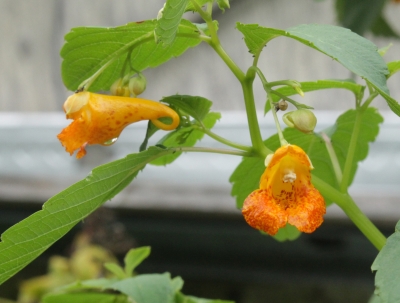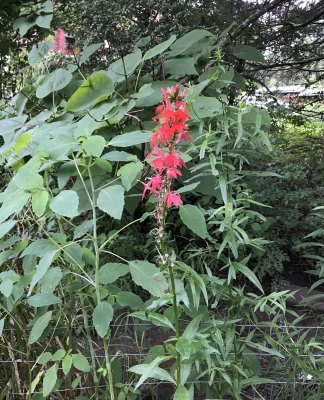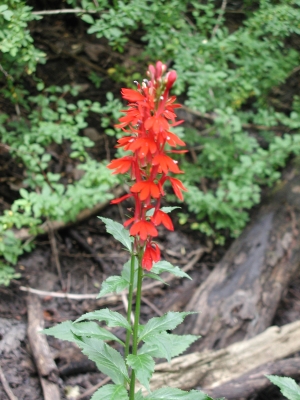A Cardinal And A Jewel
And This Year’s Winner Is . . .
Organizations annually tout their “plant of the year.” There’s the Perennial Plant Association’s 2017 plant of the year butterfly weed (Asclepias tuberosa); Proven Winners 2017 Landscape Plant of the Year is Yuki Cherry Blossom Deutzia; American Conifer Society Collectors’ Conifer of the Year is Primo Eastern Arborvitae (Thuja occidentalis ‘IslPrim’); Assembly magazine’s 2016 Plant of the Year is Bosch Rexroth . . . whoops, the last is an assembly plant (hydraulic motors and pumps). Anyway, you get the picture.
How about a new category, the Weed of the Year? Here on my farmden, I nominate and elect jewelweed (Impatiens capensis). This weed is all over the place this year, even far from where it’s been in the past. For this weed, being all over the place is its only flaw.
On the positive side, jewelweed is a pretty plant with very succulent stems sporting orange, sometimes yellow flowers.  It’s also been called touch-me-not for the way its seed capsules burst open with the slightest touch to project their seeds many feet — a useful characteristic for helping a weed spread although it doesn’t explain jewelweed’s spreading here in one season over a hundred feet and to the other side of my house. It’s close relative, the widely planted annual flower, impatiens, does the same thing without becoming weedy; both plants also enjoy and flower in either sun or deep shade.
It’s also been called touch-me-not for the way its seed capsules burst open with the slightest touch to project their seeds many feet — a useful characteristic for helping a weed spread although it doesn’t explain jewelweed’s spreading here in one season over a hundred feet and to the other side of my house. It’s close relative, the widely planted annual flower, impatiens, does the same thing without becoming weedy; both plants also enjoy and flower in either sun or deep shade.
Jewelweed often grows as a neighbor to poison ivy, which perhaps by some odd reasoning (to me) gave it a reputation for use as a treatment for poison ivy. My friend Bob, usually a clear thinker and very susceptible to poison ivy, decided to treat his rash, one year with jewelweed. He reported a success, as an afterthought mentioning that he applied it in conjunction with cortisone. (I’ll expect a lot of feedback, testimonials for jewelweed.)
Jewelweed’s main asset is how easy it is to remove. Even large stalks lift easily out of the ground, roots intact, with minimal soil disturbance. A machete or scythe slices easily through the stalks without the slightest resistance to decapitate the plants.
Each year in the garden is different. Jewelweed’s plans for next year won’t be evident until next June.
Red In The Shade!

Cardinal flower I planted
Slicing through a stand of jewelweed with my scythe in the deep shade along the seasonal, small stream (a ditch) in front of my property, I was taken aback by a 3-foot-high spike of fire engine red flowers. More scything, and then another spike appeared. I thought back to spring, and remembered planting cardinal flower (Lobelia cardinalis) along the stream/ditch this past spring.
Cardinal flower never ceases to take my breath away. Deep shade is not usually home to lots of showy flowers, and especially not flowers in traffic stopping colors. Only a few times in my life have I come upon cardinal flowers in the wild, and — you guessed it — each time they took my breath away.

Wild cardinal flower
Each time they were also in deep shade alongside water. Hence my choice of site for last spring’s planting.
Cardinal flowers are easily grown from seed, and no need to have a lot of them for bold effect. The plant to grow is the species, not one of the “improved” varieties. Many varieties have been bred or selected, including Alba (white flowers), Heather Pink, Angel Song (salmon and cream flowers), Ruby Slippers, and Twilight Zone (pink flowers). Color of the straight species is usually red, a very pure red, untainted by a hint of blue as are so many other red flowers.
Two Weeds(?)
Jewelweed and cardinal flower have much in common: both are native, both grow in shade, and both are pretty plants. Jewelweed is a self-seeding annual.
Cardinal flower is a perennial, unfortunately a short-lived perennial. It does self-seed to some degree for new plants to replace dead ones, but not enough for my needs. I grew my originals from seed, which is not at all difficult, and intend to do so again. If only cardinal flower could learn some reproductive habits from its neighbor in the shade.



I would desperately love seeds from either of these plants as I am a shade gardener. How… where to look for these.
Cardinal flower seeds are available online; not sure about jewelweed.
Also two of my favorite plants! I planted some Cardinal flower (again) in my garden. Last year it succumbed to drought. This year it is most likely buried by bishop’s weed. No matter. I will plant some at the lake along the shore where it is sure to flourish and reseed itself with or without my neglect. Jewelweed runs about my garden in the village as well as at the lake. At the lake I let it do whatever it wants. In the village, well, I am a bit more choosey. I do appreciate its small impatient-like flowers (I believe it is a member of the family), and so do the hummingbirds which is why I let some grow. My hummingbirds are strangely absent this year in the village, however. I think the jewel weed had a banner year with all the rain. BUT on to the testimonial! Yes, jewelweed is THE cure for poison ivy. My husband had quite an angry bit of it on his leg (from retrieving his golf ball, dangerous stuff) and tried it all … cortisone, calamine lotion, and a few other tubes of whatever until I stepped in and said try jewelweed as I had a surplus in the garden. Worked like a charm and quickly, too. He boiled the stems and put the liquid in a spray bottle to apply.
Yes, jewel weed relieves as well as cures poison ivy. Slice a section open lengthwise and apply sap directly several times a day for several days.
I have jewel weed in my partly shaded rhubarb patch here in Nova Scotia. Hummingbirds seem to love it.
Ah, when I moved into my house in 2006, the area by the stream was all beautiful jewelweed and bee balm, within the last few years it shifted quickly to garlic mustard and yellow archangel…
Things change with each years differences in weather, aging of plants, mowing, etc. My meadow looks a little different every year, but always very nice.
Jewel weed was prolific here in the Upper Hudson River area also this year. I discovered it actually is a great trap crop for Japanese Beetles. The beetles zoned in on the Jewel weed. Also the bees and hummingbirds love it so I always leave it in the wild areas of my garden and I admit it, sometimes in my other gardens I leave a few plant and get rid of after it flowers.